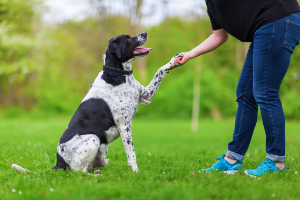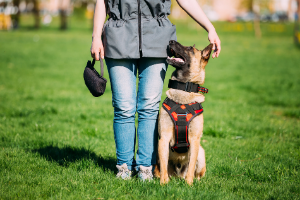“That’s a face only a mother could love.” Perhaps this has been said about your dog, and it’s true—even if your dog’s got an underbite and googly eyes, they are likely perfect to you. You love them unconditionally and think they’re perfect...that is, perhaps, until you take them for a walk. This trouble with dog-walking is an all-too-common scenario that we veterinarians hear about, and in honor of this being National Train Your Dog Month, we’d love to help you nip this bad behavior in the bud. We want to help because bad behavior is a huge reason many families end up rehoming dogs, and we don’t want you or your dog to have to go through that excruciating situation. It isn’t just leash manners—there are a few other basics that your dog should know that will make your life so much more pleasant!
Dog training is beneficial in so many ways—as The Human Animal Bond Research Institute, or habri.org, notes, it helps stimulate your dog, and spending that quality time with them increases your bonding. Your dog is never too young or too old for training. If you haven’t worked on training, you can still integrate it into your life. If you need help, there are excellent certified dog trainers out there that you can find that will fit your needs, or at least to get you started. Find a dog trainer that trains with positive reinforcement, as this is more effective than punishment-based training.
We’re sharing five tips for training your dog below. To incorporate these suggestions, you will want to set aside at least 15 minutes of your undivided attention and have high-reward treats or a toy that your dog loves nearby. Right after you give the command, reward your dog immediately. You don’t want any hesitation or your dog to do another action, as you could end up rewarding them for something other than what you asked them to do.

#1 - Recall Command
Does your pup know their name and come to you when called? Their name is the number one thing that your dog should know. You should never call your dog to come to you and punish them. They are more likely to come to you if they know they will get treats or an “atta-boy.”
Start in an enclosed area with no distractions and call your dog to you and give treats. Once your dog has this down, try it in an area with distractions. Make sure that your treats are more interesting than the possible distractions. When it is time to work on this out in the open, you will want to have a safeguard in place, like a 15-foot training lead or rope. Do this with and without treats. Even when your dog has mastered this, continue to work on it throughout their years. You always want your dog to come to you when you call them.
Why is this important?
If your dog is ever in a dangerous situation, having your dog come to you as soon as you call them could save their life.
#2 - Leave it Command
Even though teaching your dog to sit is easier to do, it is more important to teach them “Leave it.” You can use this for so many different things. This skill will take time, patience, and consistency. To start, use a dirty sock or a shoe. Put it on the floor next to you and when your dog goes to sniff it, say, “Leave it.” The moment that your dog looks at you, give them a treat. Once your dog has no interest in the sock, increase it to something more desirable like a treat.
Why is this important?
Dogs may try to investigate things that you don’t want them to; this will train them that they need to leave that alone. This method works for inanimate objects or even for other animals or people.

#3 - Look/Touch Command
The “look” and “touch” commands build upon the “leave it” command. Having them look at you means that you are about to give another command and need their attention. It’s easy, as you simply hold the treat to your face and tell your dog “look,” and then give the treat. Once they have that down, give a second command, and then the treat. The touch command is like the look command, but you want your dog to touch their nose to your palm. You can do this by placing a treat in the crack of your finger. With your hand open and fingers towards the ground, say “touch,” and when your dog’s nose touches your hand, with your other hand, give a treat. Eventually, remove the treat in the open hand and continue to work on this.
Why is this important?
This command will get your dog’s attention so that you can give a second command. You can always use it as the only command, and it will help if you need your dog’s attention for any reason or to have them close to you. This command along with the “leave it” command can help your dog if they are a jumper.

#4 - Handling
Handling is not necessarily a command, but you will want to work with your dog on getting used to being handled. As veterinarians, we always hope that dog owners will have their pets prepared for things like looking in the ears, taking a tissue and wiping the inside of your dog’s ears, lifting their lips and looking in their mouth, touching their teeth with a finger, and taking a washcloth and wiping their teeth. We also want you to be able to handle your dog’s paws and mess with their feet. You should also be able to lift their tail. Getting them used to these things early on will avoid unnecessary bites if and when your dog panics.
Start with your hand on your dog and move to the ears, mouth, feet, and tail without lifting your hand. Don’t spend a lot of time at first, as you don’t want your dog to pull away from you. Handling should be a pleasant experience, and once you are done, give them a treat.
Why is this important?
You will benefit from this when you need to brush your dog’s teeth if your dog is limping and you need to get something out of their paw, or for all grooming needs. If you are doing it regularly, you will notice anything unusual with their skin or coat. It will also make it easier for the veterinarian to examine your pet (so, thank you!) or the dog groomer to cut their nails.
These training tips are the best place to start and get your dog to master as they will make all other training so much easier. Always keep it positive, and always have rewards. Even if you are out on a walk and are not planning on training, having a treat to give your dog when they do a good behavior is valuable real-life training. You won’t ever be able to have your dog learn all their skills in a controlled environment, so it’s best to prepare yourself and your dog.
If you have any questions about training your dog or how to find a good trainer in your area, please don’t hesitate to give us a call.
